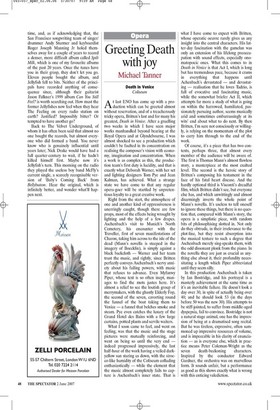Greeting Death with joy
Michael Tanner Death in Venice Coliseum t last ENO has come up with a production which can be greeted almost without reservation, and of a treacherously tricky opera, Britten's last and for many his greatest, Death in Venice. After a gruelling two weeks in which I have seen major works manhandled beyond bearing at the Royal Opera and at Glyndebourne, I was almost shocked to see a production which couldn't be faulted in its concentration on realising the composer's vision with economy, imagination and concentration. When a work is as complex as this, the production team's first duty is lucidity, and that is exactly what Deborah Warner, with her set and lighting designers Tom Pye and Jean Kalman, has achieved. What a strange state we have come to that any regular opera-goer will be startled by unpretentious loyalty to a great creative work.
Right from the start, the atmosphere of one and another kind of oppressiveness is unerringly caught, though there are few props, most of the effects being wrought by lighting and the help of a few drapes. Aschenbach's visit to Munich's North Cemetery, his encounter with the Traveller, first of seven manifestations of Charon, taking him across to the isle of the dead (Mann's novella is steeped in the imagery of Boecklin), is simply against a black backcloth — Warner and her team trust the music, and rightly, since Britten perfectly conveys Aschenbach's nervy anxiety about his failing powers, with music that refuses to advance. Even Myfanwy Piper, whose text is so often inept, manages to find the mots justes here. It's almost a relief to see the loutish group of merrymakers, with the ghastly Elderly Fop, the second of the seven, cavorting round the funnel of the boat taking them to Venice — a funnel that belches smoke and steam. Pye even catches the luxury of the Grand Hotel des Bains with a few large curtains, potted plants and servile waiters.
What I soon came to feel, and went on feeling, was that the music and the stage pictures were mutually reinforcing, and went on being so until the very end — indeed progressed impressively, the last half-hour of the work having a veiled darkyellow sun staring us down, with the sirocco-like humidity of the Coliseum colluding enthusiastically — while the element that the music almost completely fails to capture is Aschenbach's inner state. That is what I have come to expect with Britten, whose operatic oeuvre rarely gives us any insight into the central characters. His latter-day fascination with the gamelan was only an extension of his lifelong preoccupation with sound effects, especially onomatopoeic ones. What this comes to in Death in Venice is that Act I, which is long but has tremendous pace, because it crams in everything that happens until Achenbach's devastated — and devastating — realisation that he loves Tadzio, is full of evocative and fascinating music, while the somewhat briefer Act II, which attempts far more a study of what is going on within the harrowed, humiliated, passionately pursuing author, seems musically arid and sometimes embarrassingly at its wits' end about what to do next. By then Britten, I'm sure not consciously or willingly, is relying on the momentum of the plot to carry him through to the end of the work.
Of course, it's a piece that has two contexts, perhaps three, that almost every member of the audience will be aware of. The first is Thomas Mann's almost flawless story, a masterpiece at the most exalted level. The second is the heroic story of Britten's composing his testament in the face of his fatal heart disease. And the hardly optional third is Visconti's dreadful film, which Britten didn't see, but everyone else has, and which unwittingly and almost disarmingly inverts the whole point of Mann's novella. It's useless to tell oneself to ignore these things, but there is no question that, compared with Mann's story, the opera is a simplistic piece, with random bits of philosophising slotted in. Not only do they obtrude, in their irrelevance to the plot-line, but they resist absorption into the musical texture to such a degree that Aschenbach merely sing-speaks them, with the odd dissonant plonk from the piano. In the novella they are just as crucial as anything else about it, their profundity necessitating a length which Piper abbreviated until they seem silly.
In this production Aschenbach is taken by Ian Bostridge, and his portrayal is a masterly achievement at the same time as it's an inevitable failure. He doesn't look a day over 30, in spite of actually being over 40; and he should look 53 (in the days before 50 was the new 30). His attempts to be stiff-jointed, to suffer from middle-aged dyspepsia, fail to convince. Bostridge is not a natural stage animal, one has the impression of being at a dramatised song recital. But he was tireless, expressive, often summoned up impressive resources of volume, and is impeccable in his clarity of enunciation — as is everyone else, which in practice means Peter Coleman-Wright as the seven death-beckoning characters. Inspired by the conductor Edward Gardner, the orchestra was on marvellous form. It sounds unfair, but a performance as good as this shows exactly what is wrong with this enticing valediction.




















































 Previous page
Previous page